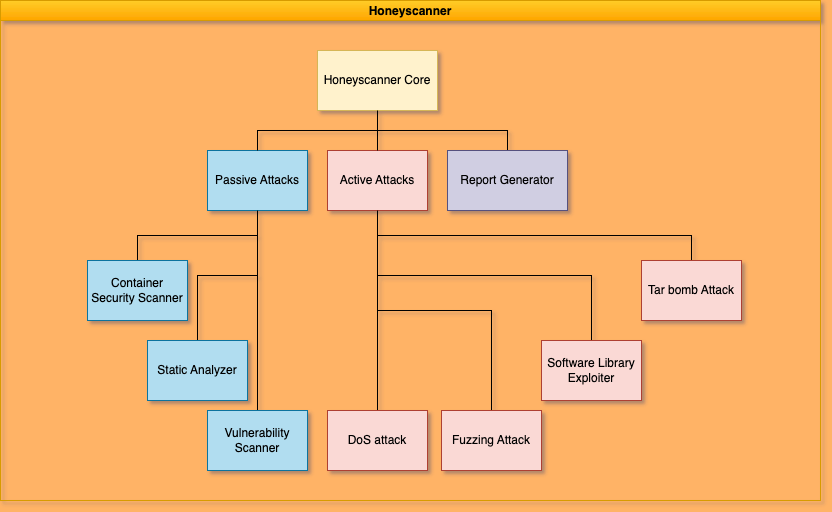This project was supported and funded by Google Summer of Code 2023. For more information about Honeyscanner in GSoC2023 click here.
This project was presented at BlackHat Europe 2023 in London. For more information about Honeyscanner in BlackHat Europe click here.
Honeyscanner is a vulnerability analyzer for honeypots designed to automatically attack a given honeypot, in order to determine if the honeypot is vulnerable to specific types of cyber attacks. It uses a variety of attacks, ranging from exploiting vulnerable software libraries to DoS, and fuzzing attacks. The analyzer then provides an evaluation report to the honeypot administrator, offering advice on how to enhance the security of the honeypot. Targeted toward security enthusiasts, open-source communities, and companies, Honeyscanner provides a much needed safety check for various honeypots.
Inspiration for Honeyscanner were the following research papers.
The following instructions will guide you through the process of setting up Honeyscanner on your local machine.
- Python v3.10.12 - Required to run the project
- Pipenv v2023.12.1 - Required to install Python dependencies
- Git - Used to download the source code
-
Download the Honeyscanner source code from GitHub. Open a tarminal and introduce the following command.
git clone https://github.com/honeynet/honeyscanner.git
-
Navigate to the Honeyscanner's folder, install the required Python packages and activate the virtual environment.
cd Honeyscanner/honeyscanner pipenv install pipenv shell
NOTE FOR PIPENV: To exit the virtual environment, you just need to enter the command "exit" in the terminal.
-
Before you run Honeyscanner, you need to control or own a Honeypot instance. For testing purposes, this guide assumes that the targeted Honeypot runs on a Docker container on the local machine, where Honeyscanner runs.
-
To test Honeyscanner against the latest Cowrie version, you can use the official Docker Image here, pull it locally and run a Docker container with it.
-
If you prefer to test Honeyscanner against Kippo, you can use the following Docker Image in DockerHub here.
-
For testing Honeyscanner against Dionaea, use the following Docker Image in DockerHub here.
-
For testing Honeyscanner against Conpot, use the following Docker Image in DockerHub here.
-
After running a Honeypot using Docker containers locally, you will be able to specify the target ip parameter with
--target-ip 127.0.0.1when running the Honeyscanner.
NOTE: NEVER RUN
HoneyscannerAGAINST HONEYPOTS YOU DO NOT OWN, OR YOU DO NOT HAVE EXPLICIT PERMISSION TO TEST.
NOTE: Currently
Honeyscannercan actively attack theDionaeaand theConpothoneypots only by using the DoS attack module. The way it works is that initiallyHoneyscanneruses nmap to find the open ports on the targeted honeypot, then tries to DoS all ports simultaneously. In order to run the nmap scanner, runHoneyscannerwith root privileges for scanningDionaeaandConpot. This provides nmap with deeper view of the services that run behind each port on the honeypot.
NOTE: For
Dionaeaonly version 0.11.0 is supported at this stage ofHoneyscanner. ForConpot, all versions up to0.6.0are supported.
Use the following examples as a reference for how to run Honeyscanner:
python3 main.py --target-ip 127.0.0.1python3 main.py --target-ip 127.0.0.1 --username root --password 1234For information on Contributors and How to contribute see our Contributors file.
The SemVer is used for versioning. For the latest available version of Honeyscanner, see page releases.
Honeyscanner does not have any release yet.
Please use Github issues to report any issues or for questions.
In case of troubles with running python on a specific version we suggest that you install the latest version of anaconda from here and use Python3.10. If you still face problems with pipenv install, try emptying your virtualenvs folder and trying again.
Distributed under the MIT license. See LICENSE for more information.








